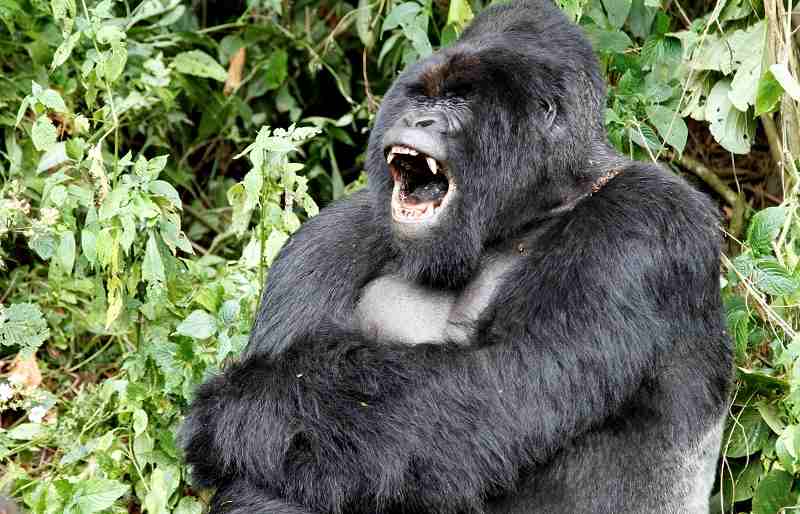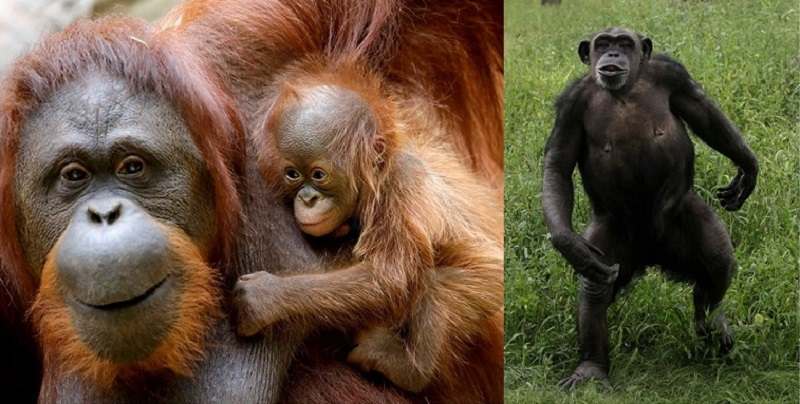
A silverback mountain gorilla yawns within the forest in Virunga National Park near Goma, Democratic Republic of Congo, in May 2014.
16:14 JST, August 18, 2022
WASHINGTON (Reuters) — Scientists have identified evolutionary modifications in the voice box distinguishing people from other primates that may underpin a capability indispensable to humankind — speaking.
Researchers said on Aug. 11 an examination of the voice box, known as the larynx, in 43 species of primates showed that humans differ from apes and monkeys in lacking an anatomical structure called a vocal membrane — small, ribbon-like extensions of the vocal cords.
Humans also lack balloon-like laryngeal structures called air sacs that may help some apes and monkeys produce loud and resonant calls, and avoid hyperventilating, they found.
The loss of these tissues, according to the researchers, resulted in a stable vocal source in humans that was critical to the evolution of speech — the ability to express thoughts and feelings using articulate sounds. This simplification of the larynx enabled humans to have excellent pitch control with long and stable speech sounds, they said.
“We argue that the more complicated vocal structures in nonhuman primates can make it difficult to control vibrations with precision,” said primatologist Takeshi Nishimura of Kyoto University’s Center for the Evolutionary Origins of Human Behavior in Japan, lead author of the research published in the journal Science.
“Vocal membranes allow other primates to make louder, higher-pitched calls than humans — but they make voice breaks and noisy vocal irregularity more common,” said evolutionary biologist and study coauthor W. Tecumseh Fitch of the University of Vienna in Austria.
The larynx, a hollow tube in the throat that is connected to the top of the windpipe and contains the vocal cords, is used for talking, breathing and swallowing.
“The larynx is the organ of voice, which creates the signal we use to sing and speak,” Fitch said.
Humans are primates, as are monkeys and apes. The evolutionary lineage that led to our species, Homo sapiens, split from the one that led to our closest living relatives, chimpanzees, roughly 6 million to 7 million years ago, with the laryngeal changes occurring sometime after that.
Only living species were included in the study because these soft tissues are not apt to be preserved in fossils. This also means it is unclear when the changes took place.
Fitch said it is possible the laryngeal simplification arose in a human forerunner called Australopithecus, which combined ape-like and human-like traits and first appeared in Africa roughly 3.85 million years ago, or later in our genus Homo, which first appeared in Africa about 2.4 million years ago. Homo sapiens originated more than 300,000 years ago in Africa.
The researchers studied laryngeal anatomy in apes including chimpanzees, gorillas, orangutans and gibbons, as well as Old World monkeys including macaques, guenons, baboons and mandrills and New World monkeys including capuchins, tamarins, marmosets and titis.
While this evolutionary simplification of the larynx was pivotal, it “did not give us speech by itself,” Fitch noted, pointing out that other anatomical traits mattered for speech over time, including a change in the position of the larynx.
Sound production mechanisms in people and nonhuman primates are similar, with air from the lungs driving oscillations of the vocal cords. Acoustical energy generated this way then passes through the pharyngeal, oral and nasal cavities and emerges in a form governed by the filtering of specific frequencies dictated by the vocal tract.
“Speech and language are critically related, but not synonymous,” said primatologist and psychologist Harold Gouzoules of Emory University in Atlanta, who wrote a commentary in Science accompanying the study. “Speech is the audible sound-based manner of language expression — and humans, alone among the primates, can produce it.”
Paradoxically, the increased complexity of human spoken language followed an evolutionary simplification.
“I think it’s pretty interesting that sometimes in evolution ‘less is more’ — that by losing a trait you might open the door to some new adaptations,” Fitch said.

Left : An 11-day-old baby male Bornean orangutan is held by his mother Suli at Bioparc Fuengirola in Fuengirola, Spain, in August 2021. Right : A chimpanzee enjoys the sun at a sanctuary in Gaenserndorf, Austria, in September 2011.
"Science & Nature" POPULAR ARTICLE
-

Genome Study Reveals Milestone in History of Cat Domestication
-

Big Leap in Quest to Get to Bottom of Climate Ice Mystery
-

Security Camera Footage Vulnerable to Outside Access; Investigation Finds 3,000 Pieces Exposed Online
-

Japan Set to Participate in EU’s R&D Framework, Aims to Boost Cooperation in Tech, Energy
-

Paws on Parade: Nairobi’s Dogs Dazzle at ‘Pawchella’
JN ACCESS RANKING
-

Tokyo Economic Security Forum to Hold Inaugural Meeting Amid Tense Global Environment
-

Keidanren Chairman Yoshinobu Tsutsui Visits Kashiwazaki-Kariwa Nuclear Power Plant; Inspects New Emergency Safety System
-

Imports of Rare Earths from China Facing Delays, May Be Caused by Deterioration of Japan-China Relations
-

University of Tokyo Professor Discusses Japanese Economic Security in Interview Ahead of Forum
-

Japan Pulls out of Vietnam Nuclear Project, Complicating Hanoi’s Power Plans
























